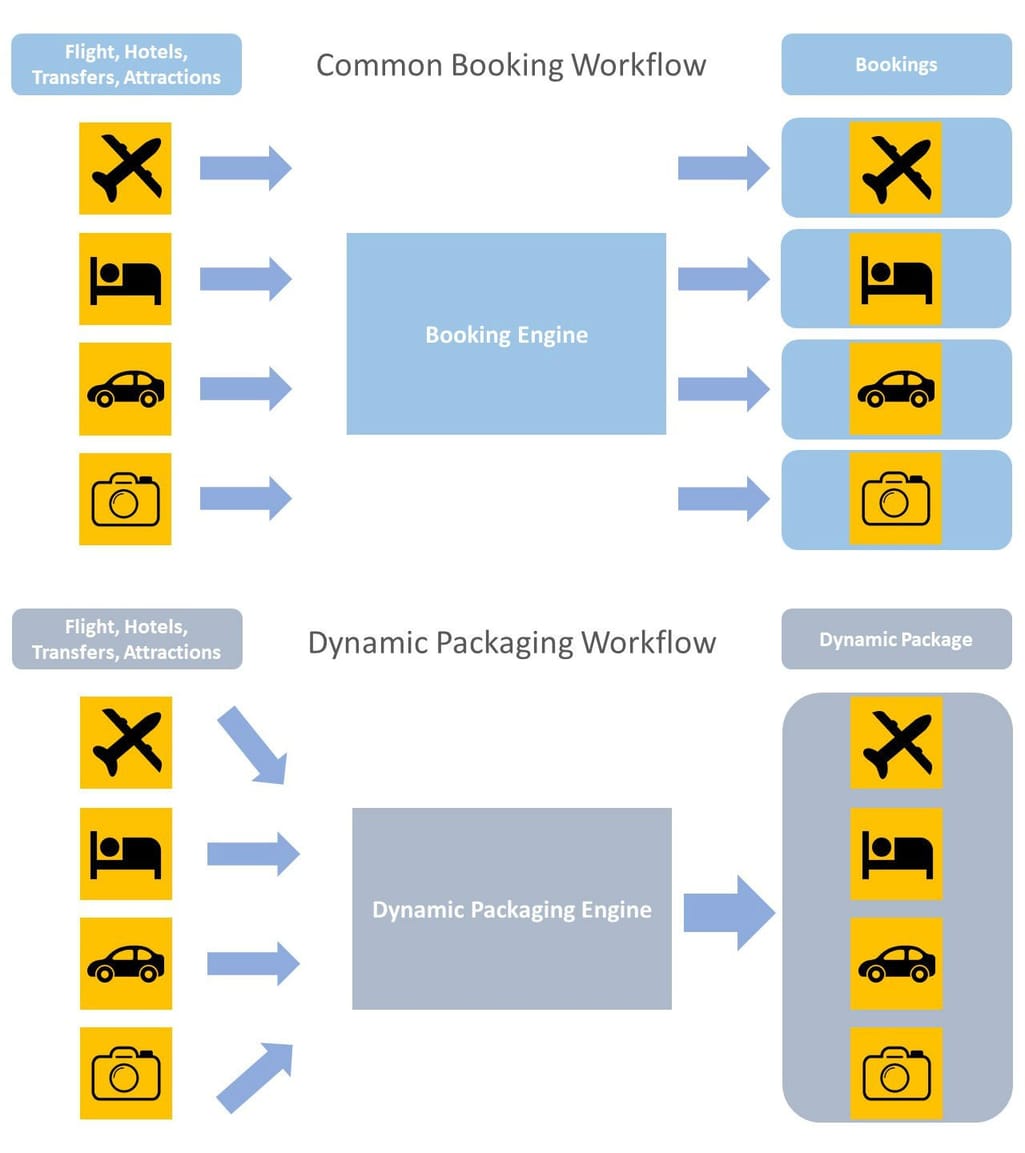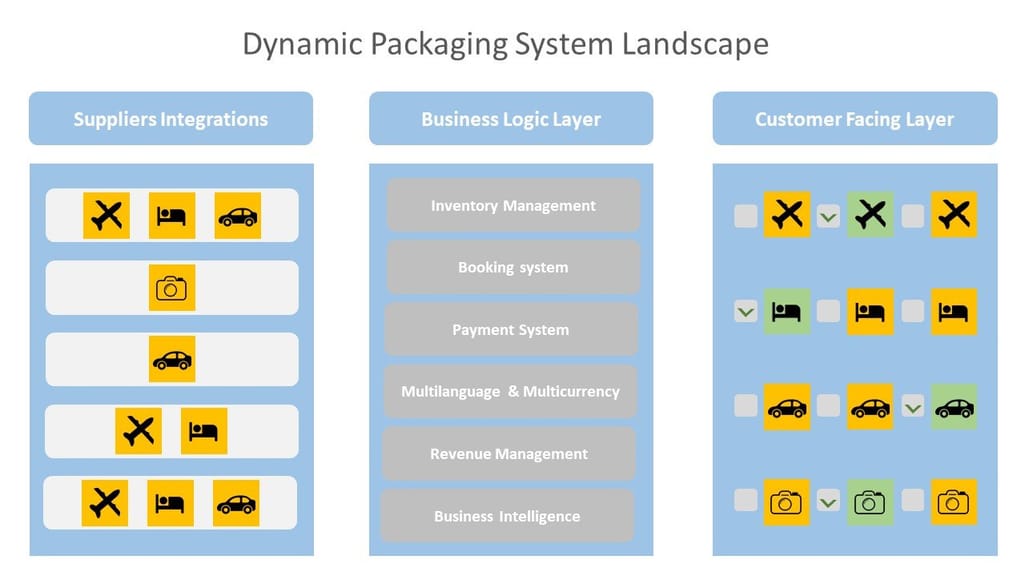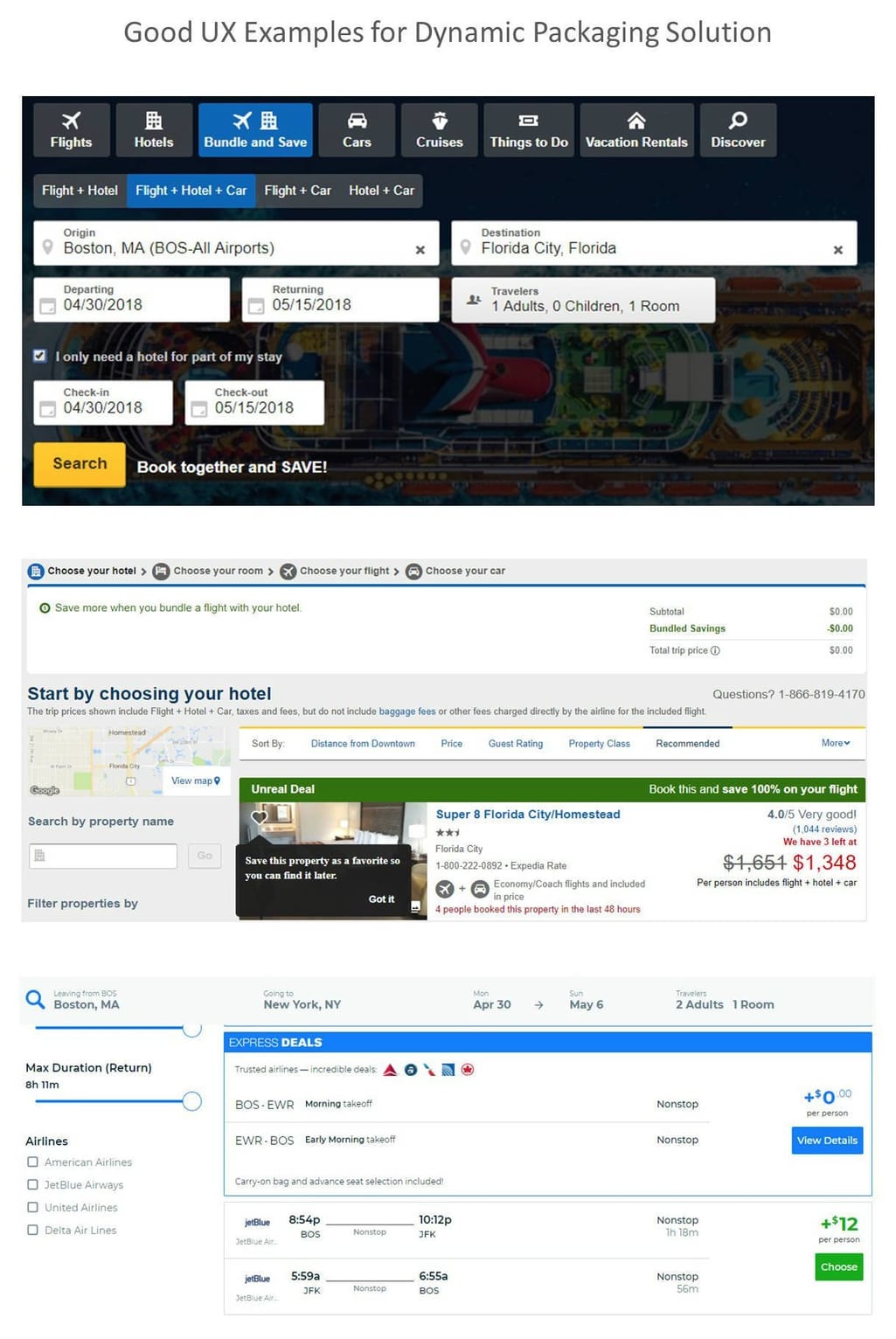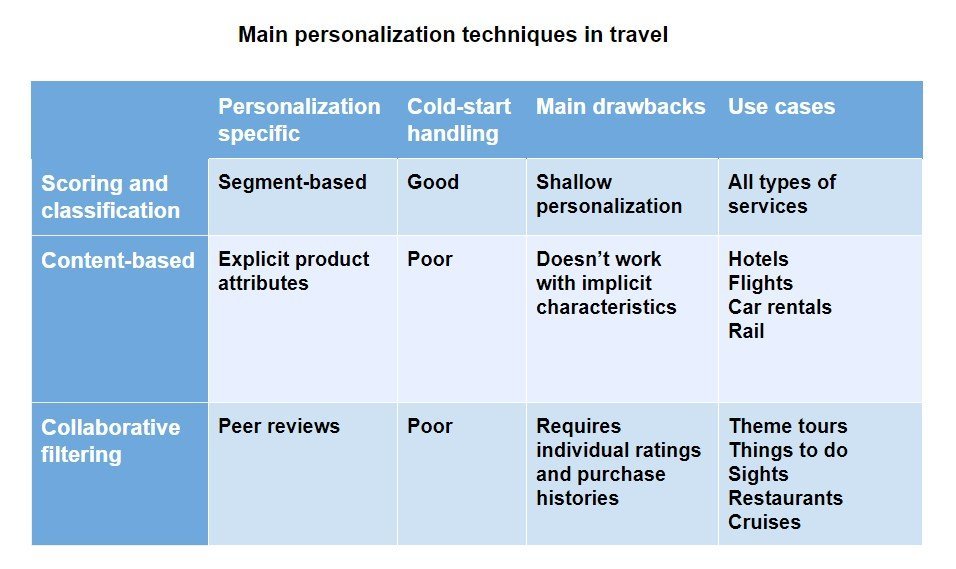Imagine not having to spend time switching between suppliers to book a room, a flight, and local activities. Think about a trip-booking solution that allows flexibly changing your tour content. Consider a platform that can easily align your budget with the entire tour, including accommodation and activities. Well, such solutions have existed for a long time and they are powered by dynamic packaging systems. Unfortunately, there are few travel industry players that have employed this approach.
Several decades ago, packaged holidays were exclusively in the province of tour operators. Time passed and new technologies opened doors to the dynamic packaging world for online travel agencies (OTAs), travel suppliers, and vacation planning tools. The old-fashioned practices combined with emerging technologies have been transformed into an innovative tool, fueling travel industry disruption.
Try Our Framework for Booking Engine Development
What is dynamic packaging in travel and tourism?
Travel dynamic packaging software is a technology that allows travelers to get customized tour packages comprised of various inventories including hotels, flights, car rentals, attractions, and events. Customers have an opportunity to take the driver’s seat in their trip and vacation planning thanks to the in-built flexibility of dynamic packaging engine solutions.
Dynamic packaging engine vs traditional booking engine
And that’s one of the main differences between traditional packaged tours and dynamic packages. Users can configure their trips via a single packaging interface and receive a full fee estimate based on individual pricing and availability of each component in dynamically generated tours.
In addition to travel content customization, package dynamism is defined by price quotation.
Types of dynamic packaging
Depending on how the pricing models are built, dynamic packaging mechanisms can be classified into the following types:
Semi-dynamic packaging. The total price of the package changes based on selected components while the price of inventories remains static. This approach is more common for systems with legacy revenue management modules. Prices are centralized and rarely changed. But when the time comes to change something, the process is done manually.
Dynamic pricing. The cost of the package is a sum of variable inventory prices. Price variability depends on factors that apply to each inventory. These can be a customer type, an inventory supplier, services availability, or demand, to name a few.
Full dynamic packaging. In this case, yield management is applied to the whole package, based on value for the customer, combination of inventories, etc. For instance, if a user chooses more expensive flights, the price of a hotel can be increased respectively.
Dynamic packaging is a win-win for both sides. Customers get rid of the headache of buying different travel-related products on different platforms. This is in addition to getting a lower price for a packaged deal than if they purchased each component individually. Suppliers, in turn, can hide their discount rates and gain greater profit.
How dynamic packaging helps travel businesses increase revenue
While dynamic packaging is not new to the travel industry, many online travel agencies are still at an early stage of adopting it. The good news is that the approach is gaining more and more popularity due to the demand for the one-stop booking shop — when consumers can reach multiple services with a single search.
So, what are the potential benefits?
Reduction of spending on marketing. Many travel companies spend lots of money on advertising and marketing to attract new customers and win back the existing ones after the pandemic.
According to the advertising AI platform MediaRadar, in 2021, travel businesses increased their spending on marketing and advertising campaigns by 38 percent compared to 2020. Not to mention commissions paid to large travel marketplaces like Booking.com or Airbnb to increase bookings.
While dynamic packaging won’t free you from third parties completely, it can help attract more customers to use your direct booking services as they can have everything they need for a trip in one place.
No need to put discounts everywhere. While discounts are quite attractive for travelers, OTAs lose a great portion of profit if putting them on all tour components to gain more customers. With the flexibility of dynamic and semi-dynamic pricing, you can still have your customers while growing your profit opportunities. Why? Because you don't cut the price for separate tour items while attracting travelers with a bundled offering that saves them money.
Avoiding the risk of unsold inventory. Some hotels, for example, may find themselves in a situation where it's impossible to sell all rooms at their usual rates, so they have to offer them at a lower price. Selling them in a bundle with some popular deals like attractions, airport transfers, or additional room services can help avoid or minimize the risk of unsold inventory without compromising profit.
Things like customer experience personalization also heat up interest for packaged tour solutions: Personalized packages potentially solve a plethora of problems related to the pre-booking research traditionally done by travelers. So, let’s see how everything works in dynamic packaging software.
Who can benefit from implementing a dynamic packaging engine?
Tour operators and OTAs are potentially the main users of dynamic packaging. Currently, most tour operators quote a total tour price while OTAs break down the pricing by components. Dynamic pricing automates the service that defines the core value for both types of businesses: providing a holistic booking experience. Tour operators automate their existing processes, while OTAs can introduce packages with all inventories properly time-related to each other and aligned to user preferences.
Dynamic packaging can also be used by hotels and airlines. By adding the ability to book services from external suppliers, such as car rentals or attractions, hotels and airlines can increase their direct bookings and complete travel shopping in one place. The customer doesn’t have to switch between providers. For example, Delta Vacations and Air Canada Vacations have already enhanced their booking capacities with hotels and car rentals.
Although dynamic packaging is aimed at cutting costs for tour operators and increasing conversions for OTAs, it has one important disadvantage. The distribution of travel packages requires businesses to reconsider their customer support efforts and make additional investments in them.
How dynamic packaging works
The typical system consists of three main layers: supplier integrations, a business logic layer, and a user-facing layer.
Three main layers of a dynamic packaging system
We’ll walk you through each layer so you have a better understanding of such systems.
Supplier integrations for the holiday packaging engine
Supplier integration is a foundation layer of any packaging engine. It defines the inventory available for booking. The selection of suppliers depends on various factors, including target markets (different suppliers provide access to inventories in different destinations), inventory availability, API support, etc.
The main engineering problem here is inventory search consolidation and system integration. The information is distributed via various APIs that differ both in terms of the inventory they offer and technology. The common source of inventories for dynamic pricing systems are:
Global Distribution Systems (GDSs). A GDS is a network system providing travel retailers with information covering airlines, hotels, and ground transfers. They return basic data such as availability rates while providing opportunities for booking. Currently, GDSs cover a significant share of the market. Mostly they are represented by such companies as Amadeus, Sabre, and Travelport. A retailer that plans to integrate its services with a GDS must meet a number of requirements.
Central Reservation Systems and Computer Reservation Systems (CRS) of hotels and airlines. These systems consolidate the information about inventories on the supplier side. An OTA or tour operator can source inventories directly from a supplier. The main drawbacks of the CRS approach are
- legacy systems,
- the absence of their own APIs, and
- the need to connect with many suppliers to achieve decent coverage.
Wholesalers and bed banks. These providers mostly cover the accommodation sphere. Wholesalers and bed banks suggest detailed information on travel inventories and provide modern API support. While they consolidate fewer suppliers than GDSs, the integration doesn’t require additional certification. Hotelbeds, Bonotel, and Cloudbeds are the main representatives in the category. The systems here are usually more innovative than those of GDSs and suppliers.
Events and attraction providers. This category includes tour and activity OTAs, local providers, and B2B wholesalers that supply information and booking capacities for museums, attractions, and events.
Car rental suppliers. Besides integrating directly with local car rental services, a smart move would be to consider the main players like CarTrawler and Rentalcars. They offer both information and booking capacities via their APIs.
To get a broader understanding of integration opportunities, consult our overview of the main travel industry APIs. We listed all key service providers and detailed their engagement approaches.
The business logic layer of dynamic packaging software
The tour packaging engine is the middle ground between inventory supply and a presentation layer. So, what are the software solutions for dynamic packaging here?
Typical dynamic packaging software includes the following functional modules.
An inventory management system that tracks and manages everything related to inventory from production to availability to end sales.
A booking engine that provides customers an opportunity to make all the needed reservations online in one place.
An integrated payment system that enables you to accept payments and streamlines the payment acceptance process automatically by integrating with your CRS.
Multilingual and multicurrency support modules will allow you to attract customers globally.
Yield management or revenue management systems help predict customer demand and sell a product at an optimal price.
A workflow management tool that enables automated coordination and organization of different tasks.
A data import/export and reporting (business intelligence or BI) module provide you with a 360° view of all the aspects of your business to help you get valuable insights and make data-driven decisions.
To enable dynamic packaging, all these components have to be cross-integrated with efficient data flow between them. So, the key barriers to integrating dynamic packaging in existing booking systems are the lack of consistency in the data collected and the slow exchange of information.
When working with legacy systems, staff needs to switch between various software environments, using separate software for booking, payments, content management, and workflow. It makes operations time-consuming and potentially inaccurate.
The other side of the problem is incompleteness and delays in data transition. Outdated prices and all lack of information about travel content frustrate customers and travel agents alike.
Additionally, dynamic packaging should employ value-added functions like AI-based recommendation engines and revenue management systems.
Customer facing layer
Building a user-friendly travel portal is a must for modern online distribution. Common booking UX in OTA doesn’t have to differ much from the UX of a travel retailer selling dynamic packages. But it must be intuitive and user-oriented.
UX of Priceline and Expedia
While package creation seems a long and cumbersome process for a user, there are some basic approaches to making it smooth and intuitive:
Modular design. You can break down the package into logical parts (e.g. Hotel> Flight >Transfer) and use an existing interface flow for each of these steps.
Price and schedule visibility. Always list multiple flight, ground transportation, and accommodation options per step and ensure that travelers can see exactly how their choices impact the final price. Besides that, you need to quote upsell price adjustments if an opaque price doesn’t apply.
Explicit data collection. Regardless of whether you have a personalization engine under the hood or not, it’s always a good practice to ask users directly about their trip specifics to better accommodate their requirements. Introduce such fields as “business traveler,” “need a hotel for a part of my stay,” “driver’s age,” and “flexible dates” to improve the search and simplify booking.
Tours and activities based on other user choices. You can use a simple rule-based recommendation engine to suggest relevant attractions to be added to the package using the location, time, and accommodation data. Suggesting T&A is a good upselling opportunity.
Chatbots for customer care. While chatbots can’t handle all customer problems, they can aid in the booking process, especially for older users.
Disruptive Technology Opportunities in Dynamic Packaging
There are more technology solutions out there that can make a dynamic packaging system more functional and modern. Here are the main ones.
Recommendation engine for packages
A recommendation engine becomes a critical aspect of any eСommerce solution. As the goal of dynamic packaging is to create a personalized end-to-end travel solution, the integration of a recommender engine can turn the system into a full-blown vacation planning platform. There are three approaches to building a personalization engine that can be used in the travel industry.
Comparison of personalization techniques
Scoring and classification. This technique divides users into broad segments by type of travel, location, budget, and destinations. It provides a basic level of personalization that can be efficient in any type of packaging solution.
Content-based personalization. Another path to building a recommendation system is applying a content-based approach. This method finds similarities between a traveler’s previous choices and predicted options. For example, if a traveler opts for a low-cost flight, the system recommends a three-star hotel. Or, if a traveler chooses a trip to Paris for two adults with a child, the system recommends a hotel with meals and tickets to Disneyland.
Collaborative filtering. A less widespread technique is collaborative filtering which suggests tailored travel products based on options picked by other users with similar characteristics. This method is more advanced and can be applied to those tours where explicit attributes like price, amenities, etc., don’t provide the full picture. These can be theme tours and specific attractions where the quality of a product is defined by the emotional experience of a traveler.
The main problem that most personalization engines face is the cold start issue. It simply means that if the system doesn’t know a user well, it will need some time to gather relevant data to provide meaningful personalized suggestions. Scoring and classification methods partly bypass this issue as they can work with initial traveler data. The other two will require more time and user action tracking to work properly.
Revenue management for packages
The revenue management module makes a dynamic packaging engine more competitive. The technique entails achieving optimal sales by using customer segmentation, supply and demand insights, yield, and pricing data.
The biggest value for the system can be generated by yield management. This functionality is critical for travel resellers. As tour providers don’t control inventories, they have to deal with many unknowns. It makes the tasks for mediators more sophisticated than that of hotels and airlines. A new trend here is to use machine learning techniques for
- demand forecasting,
- customer segmentation,
- yield optimization, and
- dynamic pricing.
A machine-learning-based system is especially valuable for online distribution. Smart algorithms allow for providing personalized offers to each client. The other benefits of the innovative approach are system autonomy, real-time data processing, and accuracy. The system can analyze behavioral, social media, and market data, assuming the right prices for the right people at the right place.
How to implement dynamic packaging
Implementation of dynamic packaging is not only a sophisticated technical task, but also an expansion to new market segments. We suggest these strategic steps to be considered for building and integrating a dynamic packaging engine:
- Research and evaluation. Define the business need. Determine why you need dynamic packaging and what goals the company plans to achieve with integration. Prepare and document requirements for the system. Determine the ROI of the project.
- Select inventory suppliers. The match will depend on the scale, types of inventory the business requires, destinations, etc. You’ll have to decide whether to go with GDSs, inventory wholesalers, join the affiliate program of some large OTA, get in touch directly with suppliers, or a combination of sources.
- Engineering. Select one of the alternatives: in-house development, engagement with a travel technology consultant, or integration with an existing software product. If you plan to build an innovative solution with an AI-based recommendation engine and advanced yield management functionality, we recommend considering consultancy involvement first.
- Reshape business processes. The new system allows a travel organization to optimize performance and boost efficiency. Assess the areas affected by integration and the changes that are required for training staff or recruitment of new specialists.
- Evaluate the project results. The results of implementation must be evaluated both by financial changes and customer feedback. Based on this information, further improvements can be added to the development pipeline.
A one-stop travel customer experience, dynamic packaging is the trend that keeps developing and growing. Single-segment OTAs can use dynamic packaging to enter new markets. This fact makes dynamic packaging a good startup opportunity. Tour operators, on the other hand, can make the customer experience more flexible by configuring packaged tours based on a precise understanding of customer preferences.
The technique can be also relevant for hotels and airlines. End-suppliers strive to increase direct bookings, but the main barrier is the customer's need to combine accommodation, flights, and car rentals to complete a vacation purchase. Dynamic packaging can help introduce end-to-end booking coverage right from the supplier’s platform. Otherwise, travelers have to rely on OTAs suggesting solutions to customers for all vacation-related problems in one place.

